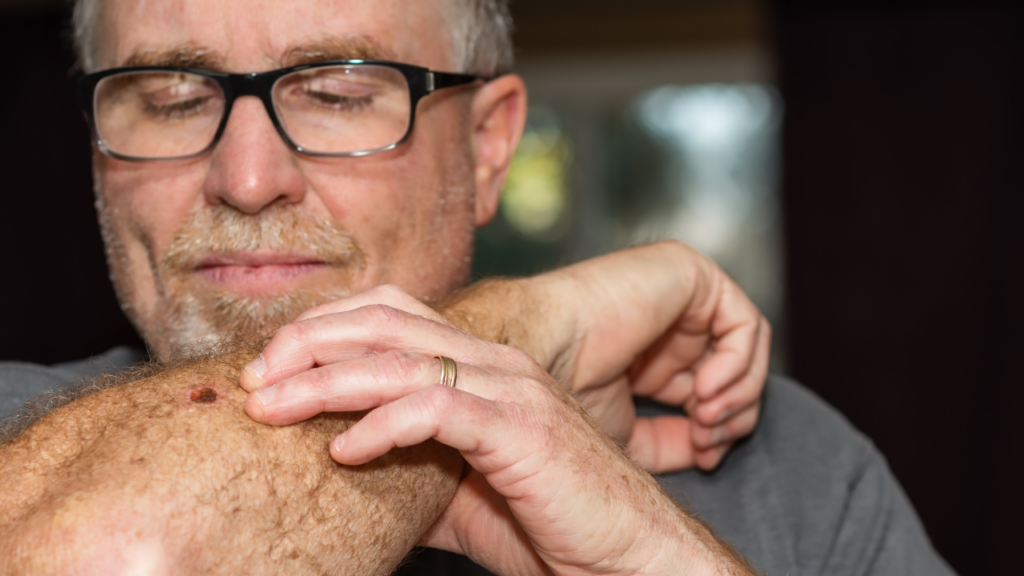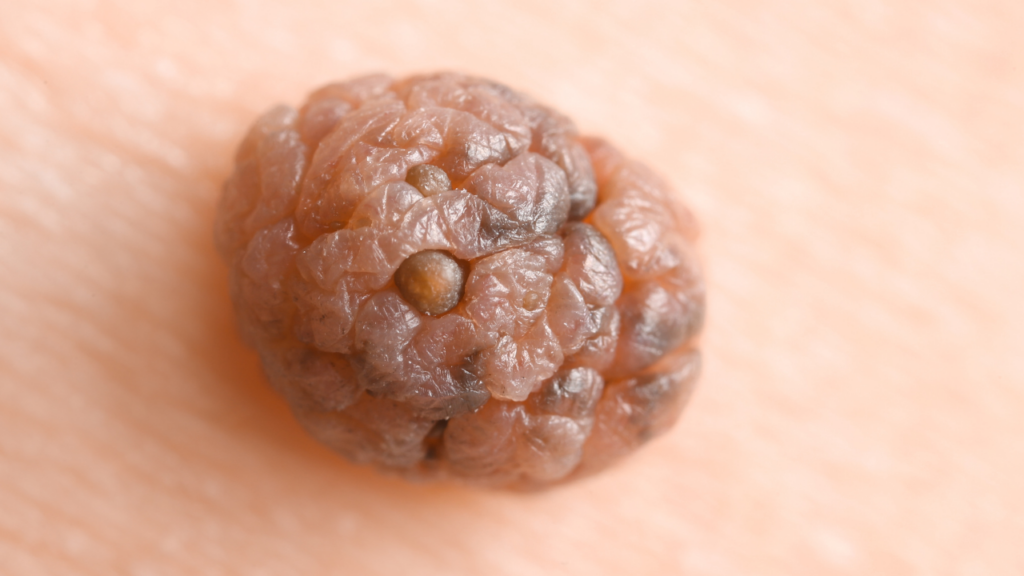|
Getting your Trinity Audio player ready...
|
Often triggered by ultraviolet (UV) radiation, skin cancer can endanger life and deteriorate quality of life if not recognized and treated in its early stages. Given its prevalent nature, it’s crucial to understand its causes and undertake preventive measures to safeguard our skin’s health.
Diligent protection and early detection are key in the battle against skin cancer. The objective of this blog is to inform and empower individuals with the knowledge necessary to take proactive steps in the management and prevention of skin cancer.
Overview of Skin Cancer
Skin cancer arises from the uncontrolled growth of abnormal cells in the epidermis, the outermost layer of the skin. Its occurrence has been growing steadily, making it one of the most common forms of cancer globally. According to the American Cancer Society, millions of cases of skin cancer are diagnosed each year, indicating a pressing need for public education on preventive strategies.
The three most common types of skin cancer are basal cell carcinoma, squamous cell carcinoma, and melanoma. Basal cell and squamous cell carcinomas are grouped together as non-melanoma skin cancers and are generally less malignant than melanoma. Melanoma, while less common, is significantly more aggressive and more likely to spread to other parts of the body if not detected early.
Understanding the impact of UV radiation on skin cells is critical. Research has established that UV rays, which reach us through sunlight and also through artificial sources like tanning beds, are the leading risk factor for most skin cancers. These rays cause DNA mutations in skin cells, which can lead to the cells growing out of control. Prolonged exposure without adequate protection increases the risk of skin cancer significantly.
Taking into account the diversity of skin types, studies show that melanin plays a protective role against UV radiation. However, regardless of skin color, everyone is susceptible to damage caused by UV rays, and thus to skin cancer. Considering risk factors such as age, weakened immune system, certain medications, and exposure to arsenic, a holistic approach to prevention is clearly needed.
Epidemiology reports highlight that early diagnosis and treatment of skin cancer lead to better health outcomes. Hence, awareness and education about skin cancer are vital in enhancing public health and reducing the burden of this disease.
Importance of Skin Protection
The necessity of skin protection is underscored by the fact that UV damage is cumulative, meaning the risk of skin cancer increases as we age with the amount of sun exposure we’ve experienced over our lifetime. Moreover, consistently high exposure to UV radiation can weaken the immune system, further reducing the skin’s ability to repair DNA damage and heightening the risk of skin cancer.
Preventive measures against skin cancer extend beyond the individual to a societal level. Education about sun safety and skin health should begin from childhood, as early exposure to UV radiation can significantly raise the risk of skin cancer later in life. Public policies and community programs can also substantially contribute to protective behaviors, promoting environments that facilitate shade and provide access to sunscreen for outdoor activities. This commitment to prevention, alongside regular skin examinations and consultations with healthcare professionals, forms the cornerstone of effective strategies for the prevention of skin cancer.

Causes and Prevention of Skin Cancer
Understanding the Causes of Skin Cancer
Skin cancer is primarily caused by genetic mutations that occur in the DNA of skin cells. As previously mentioned, the predominant factor leading to these mutations is exposure to UV radiation, which damages the DNA in our skin cells and can lead to cancerous growth.
Other risk factors also include the presence of certain types of human papillomavirus (HPV), exposure to toxic substances such as arsenic, and having a condition or taking medications that weaken the immune system, such as organ transplant drugs or the human immunodeficiency virus (HIV). Additionally, hereditary factors play a role, with some families exhibiting a higher predisposition to developing various forms of skin cancer.
Preventive Measures to Reduce Risk
Preventing skin cancer involves reducing exposure to the risk factors, most notably, minimizing UV radiation from the sun. Sun safety measures include:
- Using a broad-spectrum sunscreen with a high SPF (sun protection factor) – to block UVA and UVB rays
- Wearing protective clothing, hats, and sunglasses – to physically block the UV rays from reaching the skin
- Seeking shade – especially during midday hours when the UV index is highest
- Checking the UV index – to be aware of daily UV exposure levels and take necessary precautions
- Avoiding tanning beds and sunlamps – which are known to increase the risk of skin cancer
Monitoring skin changes and regular skin exams can also aid in detecting skin cancer early when it is most treatable.
Protect Children from Skin Cancer
A study by the American Academy of Pediatrics shows that children are particularly vulnerable to the damaging effects of UV radiation. It is essential to instill sun safety habits early on, teaching children the importance of wearing sunscreen, appropriate clothing, and staying in the shade during peak sun hours. Sunburns in childhood significantly increase the chance of developing melanoma later in life, making vigilant protection a critical step in prevention.
In schools and community settings, outdoor areas should be designed with adequate shade, and sun safety practices encouraged among young people. The use of protective gear such as hats and sunglasses should become a routine part of a child’s outdoor activities. Regular skin checks by pediatricians or dermatologists can further safeguard against unnoticed skin changes that may signify a risk for skin cancer.
Identifying Signs and Symptoms of Skin Cancer
Basal Cell Carcinoma
Basal cell carcinoma (BCC) is the most common type of skin cancer, arising from the basal cells found at the bottom of the epidermis. It most frequently develops on areas of the skin that have been exposed to the sun, such as the head, neck, and arms. BCC can present as a pearly or waxy bump, a flat flesh-colored or brown scar-like lesion, or a bleeding or scabbing sore that heals and then re-opens. While BCCs rarely metastasize, or spread, to internal organs, they can cause significant local damage by growing into surrounding tissues if left untreated.
Squamous Cell Carcinoma
Squamous cell carcinoma (SCC) originates in the squamous cells that make up the middle and outer layers of the skin. This form of skin cancer is typically not life-threatening, but it can become aggressive if neglected. SCC often appears as a firm, red nodule, or a flat lesion with a scaly, crusted surface, and it most often affects areas that experience high sun exposure, but it can occur anywhere on the body. Recognizing and treating SCC promptly can prevent complications and spread to other parts of the body.
Melanoma
Melanoma is the deadliest form of skin cancer, originating in the pigment-producing melanocytes in the basal layer of the epidermis. It can develop anywhere on the body, in otherwise normal skin, or in an existing mole that becomes cancerous. Symptoms of melanoma include large brownish spots with darker speckles, moles that change in color, size, or feel or that bleed, small lesions with irregular borders and portions that appear red, pink, white, blue, or blue-black, and dark lesions on your palms, soles, fingertips, and toes, or on mucous membranes lining your mouth, nose, vagina or anus.
Merkel Cell Carcinoma
Merkel cell carcinoma (MCC) is a rare but aggressive skin cancer that forms when Merkel cells grow out of control. MCC typically appears as a painless, firm, shiny nodule on the face, head, or neck. The growths can be red, pink, or blue, and they may grow rapidly or bleed. Early diagnosis and treatment are crucial for improving the prognosis of MCC.
Other Prevention of Skin Cancer Strategies
Avoiding Exposure to Harmful Chemicals
According to a study, exposure to certain chemicals, such as arsenic, can increase the risk of developing skin cancer. Avoiding occupations or environments where contact with these harmful substances is likely is an essential preventive strategy. For individuals who must work with hazardous materials due to occupational demands, wearing protective clothing and following safety protocols can minimize skin contact and reduce the risk of carcinogenic exposure. It’s also important for consumers to be mindful of the chemicals present in personal care products and to choose items with non-toxic ingredients.
Quitting Smoking to Reduce Skin Cancer Risk
Smoking tobacco has been associated not just with lung cancer but also with an increased risk of skin cancer, particularly squamous cell carcinoma. Quitting smoking is a critical step in reducing this risk. The effects of tobacco smoke on the skin extend beyond increasing cancer risk; it also damages collagen and elastin, leading to premature skin aging and wrinkles. By quitting smoking, individuals not only improve their overall health but also protect their skin from these harmful effects.
Consulting a Healthcare Professional for Medicines
Some medications, including certain antibiotics, cancer drugs, and diuretics, can increase the skin’s sensitivity to sunlight, potentially increasing the risk of skin cancer. It is imperative for patients to consult with their healthcare providers about the side effects of their medications. You can also educate yourself on the latest information, breakthroughs, and medical recommendations on skin cancer via exploring DrTalks.

Key takeaways
In conclusion, skin cancer remains a prevalent health concern that necessitates awareness and proactive prevention strategies. The key takeaways from this discussion on the causes and prevention of skin cancer include:
– Consistent protection from UV rays is essential. Utilizing sunscreen, wearing protective clothing, and seeking shade are foundational steps in preventing skin damage that can lead to cancer.
– Recognizing the early signs and symptoms of various types of skin cancer—such as changes in moles or the appearance of new growths—can enable early detection and increase the likelihood of successful treatment.
– Lifestyle choices, like avoiding tanning beds, quitting smoking, and steering clear of harmful chemicals, play a significant role in the prevention of skin cancer.
– Regular consultations with healthcare professionals for skin examinations and discussions about the risks associated with certain medications are also critical components of a comprehensive prevention strategy.
– Protection should extend to children, who are particularly susceptible to UV damage, through education and the institutionalization of sun safety habits.
By integrating these key points into daily life, individuals can actively reduce their risk of developing skin cancer and promote healthier living for themselves and future generations.
References
Linares, Miguel A., Alan Zakaria, and Parminder Nizran. “Skin cancer.” Primary care: Clinics in office practice 42, no. 4 (2015): 645-659.
Narayanan, Deevya L., Rao N. Saladi, and Joshua L. Fox. “Ultraviolet radiation and skin cancer.” International journal of dermatology 49, no. 9 (2010): 978-986.
Brenner, Michaela, and Vincent J. Hearing. “The protective role of melanin against UV damage in human skin.” Photochemistry and photobiology 84, no. 3 (2008): 539-549.
Bernard, Jamie J., Richard L. Gallo, and Jean Krutmann. “Photoimmunology: how ultraviolet radiation affects the immune system.” Nature Reviews Immunology 19, no. 11 (2019): 688-701.
Nowak, Martin A., and Andrew J. McMichael. “How HIV defeats the immune system.” Scientific American 273, no. 2 (1995): 58-65.
Balk, Sophie J., and Council on Environmental Health and Section on Dermatology. “Ultraviolet radiation: a hazard to children and adolescents.” Pediatrics 127, no. 3 (2011): e791-e817.
Rossman, Toby G., Ahmed N. Uddin, and Fredric J. Burns. “Evidence that arsenite acts as a cocarcinogen in skin cancer.” Toxicology and applied pharmacology 198, no. 3 (2004): 394-404.
De Hertog, Sofie AE, Christianne AH Wensveen, Maarten T. Bastiaens, Christine J. Kielich, Marjo JP Berkhout, Rudi GJ Westendorp, Bert J. Vermeer, Jan N. Bouwes Bavinck, and members of the Leiden Skin Cancer Study. “Relation between smoking and skin cancer.” Journal of Clinical Oncology 19, no. 1 (2001): 231-238.





